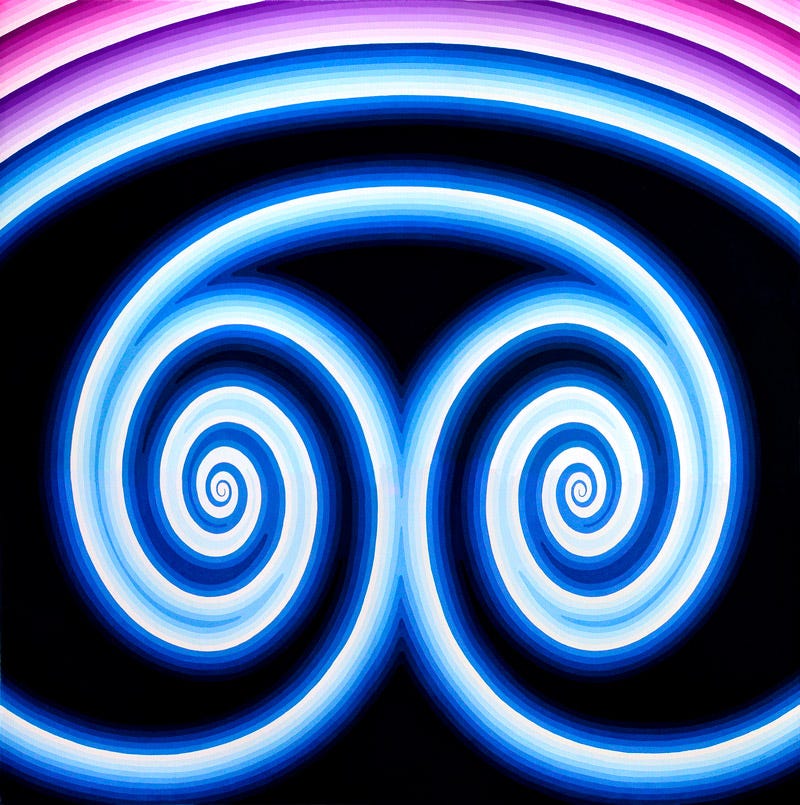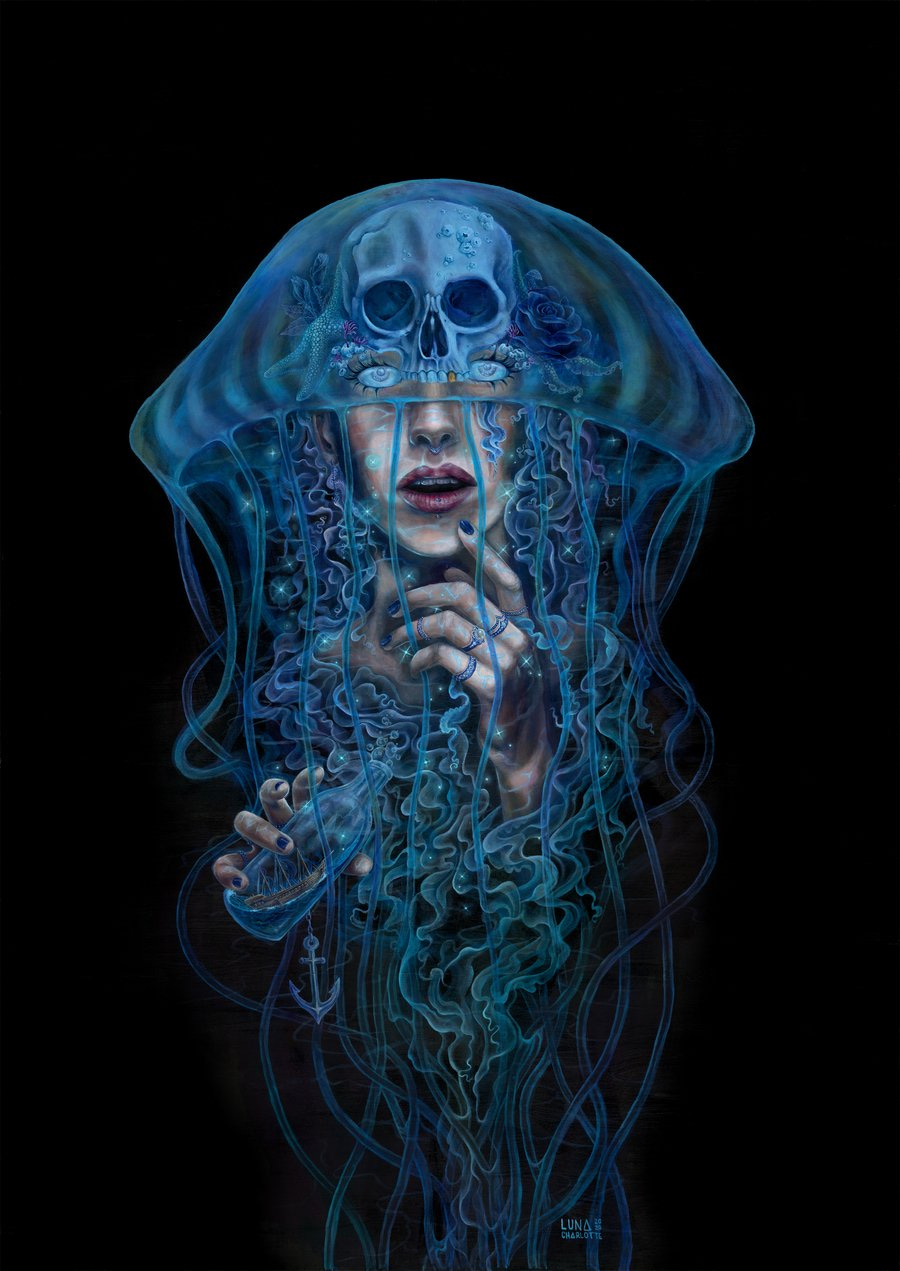Krisztina Lazar curates art shows at the Alembic, where she also regularly teaches “Alligator Lizards in the Air,” a workshop on creativity and integration. Here she reflects on the inspiration for the current art exhibition, which will be on display until January 20th.
Have you read it aloud? I’m guessing you haven’t, but you should. Maybe by the end of this you’ll be inspired to do so.
I have. And it may have changed me forever.
“The Thunder, Perfect Mind” is a “Gnostic” poem. We call it Gnostic because we really don’t know what else to call it. It was discovered amongst the Nag Hammadi cache in 1945 in a cave outside of Qumran, Egypt. This collection of 13 codices were hidden away sometime around the 4th century in order to preserve them, but we still don’t know by whom. “The Thunder” is bound alongside a segment of Plato’s Republic, “The Discourse on the Eighth and the Ninth,” the Asclepius and several other treatises, in the intriguing collection contained in Codex VI. The text is preserved in Coptic, the language of Egyptian written with Greek letters with some Demotic to help with native Egyptian sounds. There is linguistic evidence that it was probably originally composed in that language as well, unlike the rest of the library which was written originally in Greek. There are also suggestions that it was meant to be read, sung or otherwise performed aloud to an audience, as the listeners are constantly called out and spoken to throughout the text. But despite reading the poem a couple dozen times over the years, I have never once said it out loud—until recently.
The art exhibition on the walls of the Alembic was curated with this poem in mind. From my curatorial perspective, each artwork embodies an aspect, mood or verse from the text. The theme is the sacred feminine, but not in the way we often think about it nowadays. This Sacred Feminine is raw, bloody, and real, like the bared fangs of a lioness while she lovingly nurses her cubs. The poem speaks in paradox, saying and unsaying in an almost trance-inducing rhythm meant to break the listener out of normal consciousness. This is how I experience the Divine. It is this slippery paradoxical holographic quality that seems the most true to me. It is why experiencing the ineffable is a mystery in it of itself. Just as the Magus card from the Thoth Tarot implies, once you live a peak experience, you can never truly speak about it in the mundane world. Words cannot capture the essence of the holy of holies. The experience can’t be replicated or duplicated in our normal states of consciousness and so paradox and apophatic writing is the closest we can get to saying the unsayable.
Sometimes art can show in images what we cannot say in words. Through a combination of color and symbols we can get closer to representing something that refuses to be held down. And it isn’t any of the specific colors or symbols that does the trick, but rather the mysterious thing that is in between them all. I chose the artworks in this exhibition because to me, the in-between-ness of the pieces makes me feel into the realms beyond and gives me a tingling sensation that the veil is just slightly thinner in their presence.
During the opening, I read the poem aloud to everyone in attendance. Like a storm brewing, the words began collecting into giant thunderclouds, growing higher and higher and becoming ever more charged with spiritual lightning. Soon it was as though something was saying them through me and I was listening alongside everyone else. I could have been Zeus himself, hurling his bolts of lightning down onto the world below with each stanza I read. The experience was like a summoning or a grimoire working. I could have been Jack Parsons calling out to Babylon during his fateful rites at her unholy holy altar. It felt like a fissure to another world was opening. But since we were not performing a ritual, not praying to a deity, and not conducting a ceremony, it was best to keep it closed. Personally, I wasn’t ready to encounter whoever we were calling in during an art reception and I don’t think anyone else signed up for that either. But it was clear that these words are meant to evoke and part of me trembles in awe before their power.
You could have heard a pin drop when I finished. The energy in the room was charged but also extraordinarily still and serene, like we had all been singing kirtan for hours and finally collapsed in blissful exhaustion. Yes, “Thunder” is meant to be performed aloud, perhaps while the reader holds a kapala filled with blood in one hand and a ceremonial dagger in the other while someone beats a rhythm on a large stretched skin drum. Without meaning to be, I have become a devotee of whatever ancient deity this poem calls out to. I can’t stop thinking about the feeling of saying these words aloud.
So I invite you to try it as well. Speak the revelation into Being. Sink into the non-duality of the deep cosmic ocean the words rock you into. And the next time you visit the Alembic, take a look at the artwork on the walls with fresh eyes. What timeless knowing is looking back at you between the cracks?
Transmutations is a biweekly publication from the Berkeley Alembic, a post-denominational spiritual center that offers classes, workshops, retreats, and warm cups of tea.






Wikipedia says the original was written in Greek.
I think it is a Heraclitian text that has been added on to. https://ataraxiaorbust.substack.com/p/the-thunder-perfect-mind-a-heraclitean
As a strange synchronicity, I read this very same poem this week, in the beautiful book Longing for Darkness: Tara and the Black Madonna by China Galland. China's comment is that this poem could have been written about Kali rather than the Mother of God, Mary.
Is there a recording of you reading it aloud. I would love to hear it.